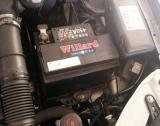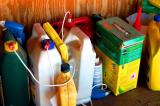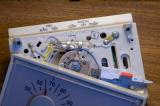Universal Waste
On this page:
- Overview of the Universal Waste Program
- Types of Federal Universal Waste
- U.S. State Universal Waste Programs
Overview of the Universal Waste Program
EPA’s universal waste regulations streamline the hazardous waste management standards for certain categories of hazardous waste that are commonly generated by a wide variety of establishments. The streamlined regulations:
- promote the collection and recycling of universal waste,
- ease the regulatory burden on retail stores and other generators that wish to collect these wastes and transporters of these wastes, and
- encourage the development of municipal and commercial programs to reduce the quantity of these wastes going to municipal solid waste landfills or combustors.
The federal universal waste regulations are found in Title 40 of the Code of Federal Regulations (CFR) in part 273 and apply to five types of universal waste:
- Batteries
- Pesticides
- Mercury-Containing Equipment
- Lamps
- Aerosol Cans
There are also four types of regulated participants in the universal waste system:
- Small quantity handlers of universal waste (accumulates less than 5,000 kg of universal waste),
- Large quantity handlers of universal waste (accumulates 5,000 kg or more of universal waste),
- Universal waste transporters and,
- Universal waste destination facilities.
In general, materials managed as universal waste can be stored for a year and are not required to be shipped with a manifest or by a hazardous waste transporter. In addition, once subject to the universal waste regulations, universal wastes do not need to be counted toward a generator’s category (i.e. very small quantity generator, small quantity generator, or large quantity generator). The universal waste regulations do require that the materials be managed in a way that prevents releases to the environment. The requirements are tailored to each specific type of universal waste and differ for small quantity handlers and large quantity handlers. Finally, the standards also include a labeling requirement, a requirement to respond to releases, and a requirement for universal waste to ultimately be managed at a facility that is permitted or otherwise designated for receiving hazardous waste, like a hazardous waste recycler.
- Check out Chapter 3 of the RCRA Orientation Manual for a summary of the universal waste program
- Read through frequent questions about universal waste
- View the 1995 final rule (PDF)(60 pp, 780 K, About PDF) that established the universal waste program (60 Federal Register 25492)
- View the 1999 final rule (PDF) (25 pp, 262 K, About PDF) that added hazardous waste lamps to the universal waste program (64 FR 36466)
- View the 2005 final rule (PDF) (16 pp, 253 K, About PDF) that added mercury containing equipment (which encompasses thermostats) to the universal waste program (70 FR 45508)
- View the 2019 final rule (PDF) (19 pp, 369 K, About PDF) that added aerosol cans to the universal waste program (84 FR 67202)
Types of Federal Universal Waste
The federal regulations identify five specific categories of materials that can be managed as universal wastes: batteries, pesticides, mercury-containing equipment, lamps and aerosol cans. The part 273 regulations define the type of materials that fall under the universal waste categories and specify in what situations that material can be considered a universal waste.
Click on each of the materials below to learn more about each universal waste category:
Batteries
40 CFR section 273.9 defines a battery as a device consisting of one or more electrically connected electrochemical cells which is designed to receive, store, and deliver electric energy. An electrochemical cell is a system consisting of an anode, cathode, and an electrolyte, plus such connections (electrical and mechanical) as may be needed to allow the cell to deliver or receive electrical energy. The term battery also includes an intact, unbroken battery from which the electrolyte has been removed.
Some batteries meet the above definition but are not universal wastes. These include spent lead-acid batteries that are being managed under the requirements of 40 CFR part 266 subpart G; batteries that are not waste because they have not been discarded; and batteries that are not hazardous waste. See 40 CFR section 273.2 for more information about universal waste batteries.
Pesticides
40 CFR part 273.9 defines a pesticide as any substance or mixture of substances intended for preventing, destroying, repelling, or mitigating any pest, or intended for use as a plant regulator, defoliant, or desiccant, with the exception of any that is (a) a new animal drug under FFDCA section 201(w), or (b) an animal drug that has been determined by regulation of the Secretary of Health and Human Services not to be a new animal drug, or (c) an animal feed under FFDCA section 201(x) that bears or contains any substances described by either (a) or (b).
The universal waste regulations can be used to manage pesticides that have been recalled if they are either stocks of a suspended and canceled pesticide that are part of a voluntary or mandatory recall under FIFRA Section 19(b) (including, but not limited to those owned by the registrant responsible for conducting the recall) or if they are stocks of a suspended or canceled pesticide, or a pesticide that is not in compliance with FIFRA, that are part of a voluntary recall by the registrant. Universal waste can also be used to manage stocks of other unused pesticide products that are collected and managed as part of a waste pesticide collection program.
- A recalled pesticide becomes a waste on the first date upon which both of the following conditions apply: (i) the generator of the recalled pesticide agrees to participate in the recall; and (ii) the person conducting the recall decides to discard the recalled materials (e.g., burn the pesticide for energy recovery).
- Note that the universal waste requirements apply only in the situation of a recall, suspension, or cancellation described above or when collected as part of a waste pesticide collection program. Hazardous waste pesticides that do not fit into these categories must be managed under the requirements in parts 260 through 272 or in compliance with 40 CFR 262.70, which addresses pesticides disposed on a farmer’s own farm in a manner consistent with the disposal instructions on the label when the container is triple rinsed.
- The universal waste requirements do not apply to pesticides that are not wastes or are not hazardous wastes
See 40 CFR section 273.3 for more information about universal waste pesticides. For more information on waste disposal programs, see the Requirements for Pesticide Disposal Web page.
Mercury-Containing Equipment
40 CFR part 273.9 defines mercury-containing equipment as a device or part of a device (including thermostats, but excluding batteries and lamps) that contains elemental mercury integral to its function.
Some mercury-containing equipment meets the above definition but is not universal waste. These include equipment or devices from which the mercury-containing components have been removed; mercury-containing equipment that is not waste because it has not been discarded; and mercury-containing equipment that is not hazardous waste. See 40 CFR section 273.4 for more information about universal waste mercury-containing equipment.
- Read the Mercury-Containing Equipment Final Rule
- Review the Mercury-Containing Equipment Proposed Rule
Lamps
40 CFR part 273.9 defines a lamp as the bulb or tube portion of an electric lighting device. A lamp is specifically designed to produce radiant energy most often in the ultraviolet, visible, and infra-red regions of the electromagnetic spectrum. Examples of common universal waste electric lamps include, but are not limited to, fluorescent, high intensity discharge, neon, mercury vapor, high pressure sodium, and metal halide lamps.
Lamps that are not waste because they have not been discarded or that are not hazardous waste are not universal wastes. See 40 CFR 273.5 for more information about universal waste lamps, as well as the resources below:
- Policy Memo about Contractors as Cogenerators of Universal Waste Lamps (PDF)(1 pp, 32.6 K, About PDF)
- Policy Memo about Reclamation of Fluorescent Lamps (PDF)(7 pp, 50.6 K, About PDF)
- View the Final Rulemaking dated July 6, 1999, 64 FR 36466 (PDF)(25 pp, 261 K, About PDF)
- Look through the Docket for the Lamp Rule
- How to Establish a Recycling Program for Mercury-Containing Light Bulbs
- Drum-top Crusher Study
Aerosol Cans
40 CFR section 273.9 defines an aerosol can as a non-refillable receptacle containing a gas compressed, liquefied, or dissolved under pressure, the sole purpose of which is to expel a liquid, paste, or powder and fitted with a self-closing release device allowing the contents to be ejected by the gas.
Aerosol cans frequently contain flammable propellants such as propane or butane which can cause the aerosol can to demonstrate the hazardous characteristic for ignitability, and may also be a hazardous waste for other reasons when discarded. Aerosol cans that do not exhibit a hazardous waste characteristic in 40 CFR part 261 subpart C or contain a substance listed as hazardous waste in 40 CFR part 261 subpart D are not hazardous waste and therefore are not universal waste. In addition, aerosol cans that meet the definition of empty in 40 CFR 261.7 are also not universal wastes.
See 40 CFR 273.6 for more information about universal waste aerosol cans.
U.S. State Universal Waste Programs
Adopting the Federal Program
The universal waste regulations can vary from state to state in the United States. The majority of states have adopted the full federal universal waste program, however, others have only adopted some of the federal universal wastes. A state does not have to include all of the federal universal wastes when they adopt the universal waste regulations. If a state doesn’t adopt a certain universal waste and the waste meets the definition of a hazardous waste, then it must be managed under the applicable hazardous waste regulations in that state. Learn more about state adoption and universal waste.
State-Specific Universal Wastes
Additionally, states may add additional universal wastes to the state's universal waste program. A more detailed list of state-specific universal wastes and more information about state additions are available on our U.S. State Universal Waste Programs Web page.
|
Materials Classified as Universal Waste in Some States |
Corresponding State |
|---|---|
|
Aerosol Cans |
California, Colorado |
|
Antifreeze |
Louisiana, New Hampshire |
|
Ballasts |
Maine, Maryland, Vermont |
|
Barometers |
New Hampshire, Rhode Island |
|
Cathode Ray Tubes (CRTs) |
Maine, New Hampshire, Rhode Island |
|
Electronics |
Arkansas, California, Colorado, Connecticut, Hawaii, Louisiana, Michigan, Nebraska, New Jersey |
|
Oil-Based Finishes |
New Jersey |
|
Paint and Paint-Related Wastes |
Texas |
|
Hazardous Waste Pharmaceuticals |
Michigan |
Note: The list above is not comprehensive.




